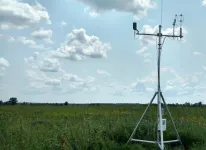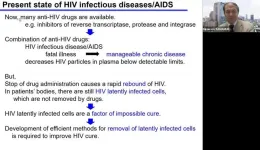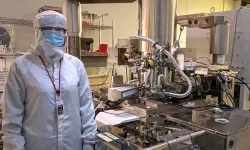(Press-News.org) When a photon interacts with a material, an interaction occurs that causes its atoms to change their quantum state (a description of the physical properties of nature at the atomic level). The resulting state is called, aptly, photoexcitation. These photoexcitations are conventionally assumed to kill one another when they come near each other, radically limiting their density and mobility. This in turn limits how efficient tools that rely on photoexcitation such as solar cells and light-emitting devices can be.
But in a study published June 19 in the journal Nature Chemistry, scientists at Northwestern University and Purdue University challenge this assumption with evidence that annihilation depends on the quantum phase relationships of photoexcitations. This means that at times photoexcitations do not annihilate each other when such quantum phases interfere destructively.
“Quantum interference is often believed to be fragile,” Northwestern’s Roel Tempelaar said. “This is an exciting new direction for the use of quantum interference enabled by detailed chemical control of molecular crystals. Our team is advancing the field by experimentally demonstrating control of annihilation by quantum interference, the principle of which was previously predicted theoretically by one of the present study’s authors. This contrasts with the currently prevailing viewpoint that annihilation proceeds as a ‘classical’ (non-quantum) process.”
Tempelaar is an assistant professor of chemistry in the Weinberg College of Arts and Sciences. He is a member of the Center for Molecular Quantum Transduction at Northwestern.
The study, led by Tempelaar and Libai Huang at Purdue University, demonstrate that quantum interference sensitively governs a photoexcitation’s behavior. By adding different chemical side-groups to identical molecules, the team made perylene diimide molecules — an industrial dye — crystallize in unique ways with different motifs. The photoexcitations inside each crystal differed starkly in their quantum phase relationships, which in turn yielded orders-of-magnitude differences in their rate of annihilation.
The team performed quantum chemical calculations to predict the difference in annihilation rates among the molecular crystals and corroborated the estimates with spectroscopic measurements. The researchers took special care to disentangle the spectroscopic contribution of excitation mobility — which allows photoexcitations to meet one another — from that of the annihilation process itself. This was achieved by time-resolved microscopy-spectroscopy, which allows mobility rates to be determined, and laser-intensity control, which allows the likelihood of annihilation to be varied.
The researchers hope their work can be used to create new devices like solar cells with photoexcitations that have high densities and mobilities. Such enhanced devices would need detailed control of photoexcitations’ quantum phases, achievable through crystals with uniquely designed packing motifs. Applications could range from optoelectronics to quantum information science.
“This research helps pave the way for more advanced molecular material design by harnessing quantum interference as a principal ingredient,” Tempelaar said.
The study, “Exciton annihilation in molecular aggregates suppressed through quantum interference,” was funded by the U.S. Department of Energy (Basic Energy Sciences grant DE-SC0019215, DE-SC0021314, and a Computational Science Graduate Fellowship DE-FG02-97ER25308).
END
Quantum interference can protect and enhance photoexcitation
Applications may include optoelectronics and quantum information devices
2023-06-21
ELSE PRESS RELEASES FROM THIS DATE:
Reducing bias and stigma associated with medication-assisted treatment improves care
2023-06-21
Medication-assisted treatment (MAT), such as naltrexone, is a well-documented successful treatment for opioid use disorder (OUD). However, there are multiple barriers for clinicians to use MAT, including clinician lack of confidence in using the treatment, their own misconceptions about the patient population, and, until recently, federally required training. Additionally, there is a stigma associated with MAT and the patients who would most benefit from it. Improving access to MAT training and integrating it into clinician programs and curriculums may remove identified barriers, decrease stigma, and enable newly trained clinicians to treat patients.
To address these barriers, ...
UNM researchers find medical cannabis patients who feel 'high' report greater symptom relief but increased negative side effects
2023-06-21
In a new study titled, “Understanding Feeling ‘High’ and Its Role in Medical Cannabis Patient Outcomes,” published in the journal, Frontiers in Pharmacology, researchers at The University of New Mexico, in collaboration with Releaf App™ found that patients who reported feeling “High” experienced 7.7% greater symptom relief and an increase in reporting of positive side effects such as “Relaxed” and “Peaceful.” However, these benefits must be weighed against a more than 20% increase in negative side effect reporting.
Senior author and Associate Professor of Psychology, ...
Screening newborns for "bubble-baby" disease saves lives
2023-06-21
Screening newborns for severe combined immunodeficiency disease (SCID) significantly increases the survival of children after bone marrow transplantation, a new North American study finds.
Published today in The Lancet with an accompanying editorial, the retrospective study was co-led by Elie Haddad, an Université de Montréal medical professor and clinician scientist, pediatrician and immunologist at the UdeM-affiliated CHU Sainte-Justine mother-and-child hospital.
The research shows that the gradual adoption of newborn screening for SCID since 2008 in North America has boosted the survival rate from 73 per cent between 1982 and 2009 to ...
Rain gardens could save salmon from toxic tire chemicals
2023-06-21
Specially designed gardens could reduce the amount of a toxic chemical associated with tires entering our waterways by more than 90 per cent, new research shows.
Tired toxins
The chemical 6PPD-quinone can form when car tires interact with the atmosphere. It enters rivers and streams when rain runs off roads into waterways. It is toxic to coho salmon, rainbow trout and some other fish.
“Rain gardens”, or bioretention cells, are gardens engineered to reduce flooding and soak up contaminants when road runoff is directed ...
New MU study examines variability of water, carbon in Missouri agriculture ecosystems and future impact on crops
2023-06-21
One of the main reasons plants use water is to allow them to absorb carbon dioxide from the atmosphere. This means that, in plants, the water and carbon cycles are tightly linked. In a new study, researchers from the University of Missouri and the United States Department of Agriculture (USDA) used this foundational principle to identify sustainable farming practices aimed at helping staple crops like corn and soybeans thrive during extreme weather conditions that have become more common in the Midwest.
This study examined how farming practices affect crop resilience to climate change by examining water and carbon ...
Welcoming two new journals to the PLOS portfolio: PLOS Mental Health and PLOS Complex Systems
2023-06-21
SAN FRANCISCO — PLOS today is announcing that it will soon launch two new journals: PLOS Mental Health and PLOS Complex Systems. PLOS sees these new journals as an opportunity to give evolving research communities opportunities to forge a new path for research in the field. Whether that means welcoming new ways of sharing research transparently or cementing new policies that enable research to be evaluated and rewarded more fairly, or simply finding a broader audience where research can make a greater real-world impact.
PLOS Mental Health provides a dedicated venue for all mental health research, connecting global experts from a broad range of disciplines and addressing challenges ...
A new, promising weapon in the fight against HIV
2023-06-21
A research team led by Tokyo Medical and Dental University (TMDU) has identified a molecular compound that activates latent HIV-1 in cells, showing promise for HIV treatments
Tokyo, Japan – A multi-institutional research group led by researchers from Tokyo Medical and Dental University (TMDU) has made a significant and promising step forward in our ability to treat human immunodeficiency virus type 1 (HIV-1), the virus underlying acquired immunodeficiency syndrome (AIDS).
To appreciate their accomplishment, we must first know a little about why HIV-1 is difficult to eliminate. ...
A roadmap for gene regulation in plants
2023-06-21
– By Will Ferguson
For the first time, researchers at the Department of Energy’s Lawrence Berkeley National Laboratory (Berkeley Lab) have developed a genome-scale way to map the regulatory role of transcription factors, proteins that play a key role in gene expression and determining a plant’s physiological traits. Their work reveals unprecedented insights into gene regulatory networks and identifies a new library of DNA parts that can be used to optimize genetic engineering efforts in plants.
“Transcription factors regulate things like how plants grow, how much fruit they produce, ...
Cave excavation pushes back the clock on early human migration to Laos
2023-06-21
CHAMPAIGN, Ill. — Fifteen years of archaeological work in the Tam Pa Ling cave in northeastern Laos has yielded a reliable chronology of early human occupation of the site, scientists report in the journal Nature Communications. The team’s excavations through the layers of sediments and bones that gradually washed into the cave and were left untouched for tens of thousands of years reveals that humans lived in the area for at least 70,000 years – and likely even longer.
“When we first started excavating the cave, we never expected to find humans in that region,” said University of Illinois Urbana-Champaign anthropology professor Laura Shackelford, who led ...
New microcomb device advances photonic technology
2023-06-21
A new tool for generating microwave signals could help propel advances in wireless communication, imaging, atomic clocks, and more.
Frequency combs are photonic devices that produce many equally spaced laser lines, each locked to a specific frequency to produce a comb-like structure. They can be used to generate high-frequency, stable microwave signals and scientists have been attempting to miniaturize the approach so they can be used on microchips.
Scientists have been limited in their abilities to tune these microcombs at a rate to make them effective. But a team of researchers ...
LAST 30 PRESS RELEASES:
Heart-brain connection: international study reveals the role of the vagus nerve in keeping the heart young
Researchers identify Rb1 as a predictive biomarker for a new therapeutic strategy in some breast cancers
Survey reveals ethical gaps slowing AI adoption in pediatric surgery
Stimulant ADHD medications work differently than thought
AI overestimates how smart people are, according to HSE economists
HSE researchers create genome-wide map of quadruplexes
Scientists boost cell "powerhouses" to burn more calories
Automatic label checking: The missing step in making reliable medical AI
Low daily alcohol intake linked to 50% heightened mouth cancer risk in India
American Meteorological Society announces Rick Spinrad as 2026 President-Elect
Biomass-based carbon capture spotlighted in newly released global climate webinar recording
Illuminating invisible nano pollutants: advanced bioimaging tracks the full journey of emerging nanoscale contaminants in living systems
How does age affect recovery from spinal cord injury?
Novel AI tool offers prognosis for patients with head and neck cancer
Fathers’ microplastic exposure tied to their children’s metabolic problems
Research validates laboratory model for studying high-grade serous ovarian cancer
SIR 2026 delivers transformative breakthroughs in minimally invasive medicine to improve patient care
Stem Cell Reports most downloaded papers of 2025 highlight the breadth and impact of stem cell research
Oxford-led study estimates NHS spends around 3% of its primary and secondary care budget on the health impacts of heat and cold in England
A researcher’s long quest leads to a smart composite breakthrough
Urban wild bees act as “microbial sensors” of city health.
New study finds where you live affects recovery after a hip fracture
Forecasting the impact of fully automated vehicle adoption on US road traffic injuries
Alcohol-related hospitalizations from 2016 to 2022
Semaglutide and hospitalizations in patients with obesity and established cardiovascular disease
Researchers ‘listen in’ to embryo-mother interactions during implantation using a culture system replicating the womb lining
How changing your diet could help save the world
How to make AI truly scalable and reliable for real-time traffic assignment?
Beyond fragmented markets: A new framework for efficient and stable ride-pooling
Can shape priors make road perception more reliable for autonomous driving?
[Press-News.org] Quantum interference can protect and enhance photoexcitationApplications may include optoelectronics and quantum information devices




